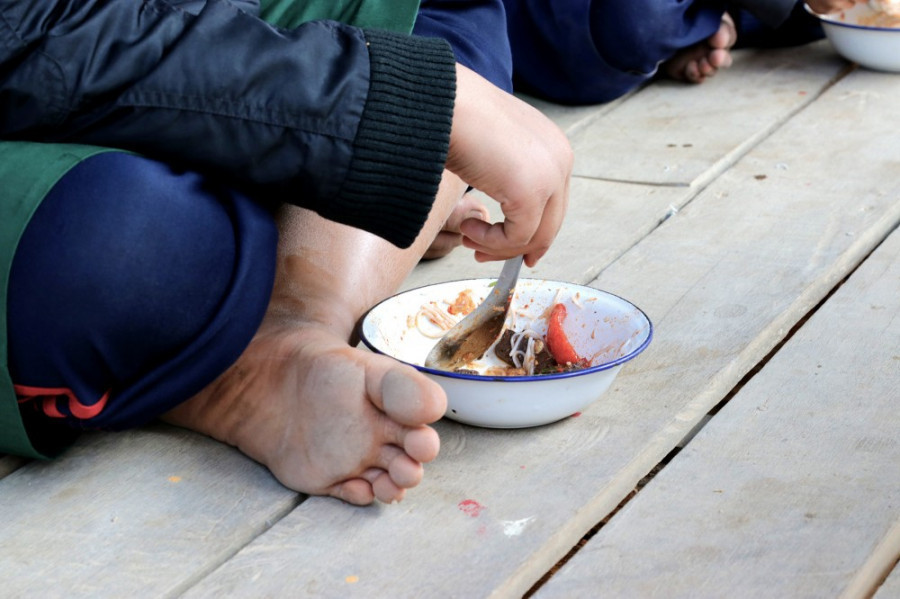Health
Malnutrition was worsening before the pandemic, but with job losses of parents it could get worse, experts say
A 2016 study had found that 10 percent of the children under five were suffering from wasting, but a 2019 study found that figure had reached 12 percent. In Karnali this figure is as high as 17.6 percent.
Arjun Poudel
Fourteen-month-old Susma Chepang of Benighat Rorang Rural Municipality-2, Dhading weighs just six kg. Her mid-upper arm circumference measurement is 10.5 cm.
Both indicators show that the toddler is suffering from severe acute malnutrition, a life threatening condition.
According to the World Health Organization, a 14 month-old girl should weigh at least 9.4 kg and a boy around 10.1 kg. It says that children’s mid-upper arm circumference should measure at least 13.5 cm, and that those children whose mid-upper arm measures less than 11 cm should be immediately referred for treatment.
“We have around 50 children suffering from severe acute malnutrition and over 100 children suffering from moderately acute malnutrition in our rural municipality,” Shankar Duwadi, health coordinator at the rural municipality, told the Post over the phone from Dhading.
The problem of malnutrition has been escalating quickly amidst the ongoing coronavirus pandemic, according to nutritionists. If the report of the Multiple Indicator Survey-2019 is anything to go by, the nutrition condition of the country had worsened long before the start of the pandemic.
The report showed that 12 percent of children under five suffer from wasting. Wasting or low weight for a particular height is an undernutrition condition, which is a strong predictor of mortality among children under five, according to the UN health agency. Wasting in children is associated with a higher risk of death, if not treated properly, according to it.
Only 10 percent of children under-five were suffering from wasting, according to the Nepal Demographic Health Survey-2016.
“We don’t know what is the exact condition of malnutrition at present, but the condition has become worse than 2011,” Dr Bikash Lamichhane, former director at the Child Health Division, told the Post. “We can expect that the current situation has become worse than 2019.”
In 2011, only 11 percent of children under five years old had wasting problems.
A lot of people have lost their jobs, their purchasing capacity has declined, factories have shut down, production of food crops has also declined, and children are derived from medical treatment.
The Multiple Indicator Survey-2019 showed that that prevalence of wasting among children in Karnali Province was 17.6, the highest in the country followed by Province 1 (14.3 percent) Sudurpaschim Province (14.1 percent), Province 2 (13.9 percent ) Lumbini Province (13.7 percent) Gandaki Province (8 percent) and Bagmati Province (4.7 percent).
People from low middle class families have been hit hard by the ongoing pandemic.
Doctors say that pandemic has created a multiplier effect in the health and well being of the people.
“Rise in wasting indicates that children are not getting enough nutrient food and also are being deprived of treatment,” Dr Atul Upadhyay, a nutritionist, told the Post. “This is a kind of hunger situation.”
Experts say that nutrition has a direct link with the overall development of the country. Malnutrition affects physical as well as mental growth of children, which ultimately affects the country’s economic health, according to Upadhyay.
“We are not taking the nutrition issue seriously, which is the main problem in our country,” said Upadhyay. “We do not have a post-pandemic strategy to deal with the worsening nutrition conditions.”
Studies show that for every $1 invested in preventing stunting among children generates up to $ 18 in economic returns, according to doctors.
Malnutrition plays a major role in the under five mortality rate, according to the nutrition section at the Family Welfare Division under the Department of Health Services.
“Along with the lack of sufficient nutrient foods, poor sanitation, lack of safe drinking water and treatment is blamed for wasting, ''Dr Shyam Raj Upreti, former director at the Child Health Division, told the Post. “Concerned authorities should introduce a strategy to address the issue.”
Wasting represents failure to get nutrient food in the period immediately before the survey, according to Upreti.




 14.12°C Kathmandu
14.12°C Kathmandu














